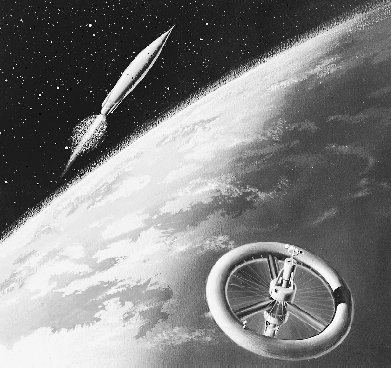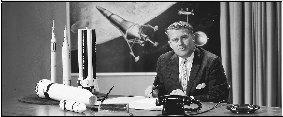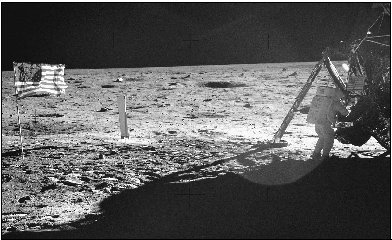Introduction
The Road to Space Stations
Space stations have been a mainstay of human space exploration since the early 1970s. Of the many types of hardware that have been blasted into space—whether orbiting satellites, reusable transport vehicles such as the shuttle, or unmanned robotic probes making one-way journeys to distant planets and beyond—none possess the complexity, technological sophistication, or size of a space station. These qualities make space stations the workhorses of space exploration. They are highly valued as medical laboratories for learning about the effects of weightlessness on humans, platforms for astronomical studies of distant stars and galaxies, and observation posts for viewing and analyzing natural and human-caused phenomena on Earth.
The technological complexity of modern space stations took decades to develop. Today's International Space Station (ISS), the latest and most complex laboratory in space, is the beneficiary of research efforts dating back to the early 1950s, when the first plans were drawn up to blast a simple satellite no larger than a large beach ball into Earth's orbit. The road to space stations began as a dream that quickly captured the imagination of scientists. These researchers' efforts resulted in technological innovations that made possible ever larger and more sophisticated space stations.

The First Dreams
Even in the late nineteenth and early twentieth centuries, space stations were viewed as solutions to many of Earth's problems. Scientists, physicians, science-fiction writers, politicians, industrialists, and some of the general public dreamed about space stations in orbit around Earth. For some, space stations promised to be places to perform cutting-edge scientific research in a weightless environment. Physicians dreamed of performing medical experiments on astronauts, and other scientists hoped to create crystals, semiconductors, and pharmaceuticals with far fewer of the imperfections caused by Earth's gravitational field. For others, space stations promised to serve as staging points for travel to distant planets or even as space colonies that might one day relieve the already apparent overcrowding and pollution on Earth.
The concept of a staffed outpost in Earth's orbit served as grist for science fiction from 1869, when American writer Edward Everett Hale published a story titled "The Brick Moon" in Atlantic Monthly magazine. In the article, Hale's manned outpost was intended to function as a navigational aid for ships plying Earth's oceans. More than fifty years later, in 1923, Romanian science-fiction writer Hermann Oberth became the first person to use space station as a term for an installation that would serve as the jumping-off place for human journeys to the Moon and to Mars. Just five years later, Herman Noordung, an Austrian scientist, published the first space station blueprint. His design consisted of a doughnut-shaped structure that comprised crew living quarters, a power-generating station attached to one end of the central hub, and an astronomical observation station.
In modern times, the first person to seriously consider the creation of space stations was the German rocket scientist Wernher von Braun. In 1952 von Braun published his concept of a space station in Collier's magazine. He envisioned a facility shaped like a wheel that would have a diameter of 250 feet and would orbit more than 1,000 miles above Earth. Space historian Randy Liebermann explains that the Collier's article was part of a broad but carefully crafted vision on von Braun's part:
After 25 years of continuous and directed thinking and endless hours of experimentation, von Braun, the world's leading rocket engineer, had the chance to come out of his sequestered military environment and through a national magazine inform the general public of his detailed blueprint for realizing manned space travel. 1
Science Energizes the Dream
Von Braun and other scientists took up the challenge of making the dream of using space stations
Wernher von Braun
Wernher von Braun was one of the most important rocket developers and champions of space exploration between the 1930s and the 1970s. Born in Germany in 1912, he became enamored with the possibilities of space exploration as a young boy by reading the science fiction of Jules Verne and H.G. Wells. As a college student, von Braun mastered calculus and trigonometry so he could understand the physics of rocketry. As a means of furthering his interest to build rockets, in 1932 he went to work for the German army to develop missiles. While engaged in this work, von Braun received his PhD in aerospace engineering in 1934.
During World War II von Braun led what has been called the rocket team, which developed the V-2 ballistic missile for the Germans. The brainchild of von Braun's rocket team, the V-2 was an early version of rockets used in space exploration programs in the United States and the Soviet Union. A liquid propellant missile forty-six feet tall and weighing twenty-seven thousand pounds, the V-2 flew at speeds in excess of thirty-five hundred miles per hour and delivered a twenty-two-hundred-pound warhead to a target five hundred miles away.
At the end of the war in 1945, von Braun and five hundred of his top rocket scientists surrendered to the U.S. Army. For fifteen years after World War II, von Braun worked with the army in the development of ballistic missiles; in 1960 his rocket development center transferred from the army to the newly established NASA. Von Braun soon became director of NASA's Marshall Space Flight Center and the chief architect of the Saturn launch vehicle used to propel Americans to the Moon.
Toward the end of his life, von Braun was one of the most prominent spokesmen of space exploration in the United States. In 1970 NASA leadership asked von Braun to move to Washington, D.C., to head up the strategic planning effort for the agency. On June 16, 1977, while still actively working on aerospace projects, he died in his home in Alexandria, Virginia.

for exploration a reality. But before anything so sophisticated as a space station could have any hope of succeeding, smaller, simpler efforts would be necessary to prove that launch vehicles would function properly, the needed altitudes could be reached, and humans could survive the stresses of launch and return to Earth.
In 1955, as a first step, American president Dwight Eisenhower announced plans to build and launch a 3.5 pound satellite into orbit. This satellite would circle Earth once, taking photographs as it did so. Unbeknownst to President Eisenhower, Premier Nikita Khrushchev of the Soviet Union had secretly issued orders for Soviet engineers to work on a similar project. The Soviets achieved success first, and on October 4, 1957, launched a satellite named Sputnik , the Russian world meaning "satellite." The USSR's accomplishment stunned the United States. Sputnik weighed an incredible 183 pounds, raising fears among Americans that they had fallen far behind the Soviets in technological and scientific prowess.
The next step was to determine if an animal could survive the launch and live in space. On November 3, 1957, the Soviets launched Sputnik 2 , which was large enough to accommodate a dog named Laika. The dog survived in space for several days, making the mission an unqualified success and paving the road for the first human in orbit.
The string of Soviet space successes continued when, in 1961, cosmonaut Yury Gagarin blasted into orbit, circling the earth once in a trip lasting 106 minutes. Gagarin's historic test flight proved that Soviet engineers were able to build spacecraft capable of carrying a human into orbit. The success also confirmed that more sophisticated vehicles such as space stations were feasible.
The Space Race
The Americans realized, as did the Soviets, that before a space station that could house astronauts for long periods in orbit could be undertaken, more experimentation was needed. Highest on their list of problems to solve was producing a rocket powerful enough to thrust far heavier payloads into orbit. Also of serious concern were understanding the effect of weightlessness on humans; perfecting pressurized suits needed for survival in the vacuum of outer space; establishing reliable systems for communication between ground crews and astronauts; providing reliable supplies of food, water, and oxygen; and testing systems for a safe return to Earth.
Desperate to overshadow the Soviet successes, the United States chose to solve these problems on a project more daring and complicated than simply building an orbital outpost. On May 25, 1961, newly elected president John F. Kennedy proposed a national objective of a manned lunar landing with these challenging words: "I believe that this nation should commit itself to achieving the goal, before this decade is out, of landing a man on the moon and returning him safely to the Earth." 2
On July 20, 1969, as hundreds of millions of people around the world watched on television sets, American astronaut Neil A. Armstrong descended from his lunar module, named Eagle, and set foot on the Moon. Following twenty-one hours on the lunar surface gathering forty-six pounds of lunar rocks and planting an American flag, Armstrong and two compatriots safely returned to Earth.
From Rockets and Satellites to Space Stations
Once humans had circled Earth and walked on the Moon, neither the United States nor the Soviet Union were much inclined toward exploring farther from Earth. According to Dr. Gary Lofgren, lunar curator and planetary geoscientist at the National Aeronautics and Space Administration's Johnson Space Center, "We found, however, no new elements or any materials significantly different from the earth. This should not be surprising because our solar system was all made from the same stuff. The differences between the planets reflect primarily their distances from the sun and the stability of various materials." 3
Disappointment over the results of lunar exploration, however, did not dampen interest in space stations among American and Soviet planners. For example, a special team of Soviet engineers busied themselves developing a space station primarily for military purposes. In a highly ambitious and super-secret project, the Soviets envisioned an orbiting outpost equipped with powerful spy cameras, radar, and even self-defense guns. It would also include supply vehicles and multiple reentry capsules.
A military space station was canceled in favor of a scientific project with wider and more practical applications. On February 9, 1970, the Soviet government officially endorsed the space station called Salyut, a Russian word meaning "greetings." As promised, at the beginning of 1970 Salyut, the world's first space station, was readied for launch in 1971.
Meanwhile, American officials backed the idea of a space station with similarly vague goals in mind. Secretary of Defense Robert McNamara publicly stated the need for a space station for defense in the late 1960s, noting:
The objective will be to test operations in space using equipment and personnel that can also meet some military needs. We propose a manned orbiting laboratory, not for a precise clearly defined military mission, but because we believe it useful to develop some technologies that could prove essential for manned military operations in space. 4
To move the program forward as quickly as possible, engineers searched for something that could be

devised schemes for use of a spent-rocket stage as a manned orbiting laboratory that helped form foundations for Skylab [America's first space station]. The Research Projects Laboratory conducted studies for science-oriented projects on board Skylab including High Energy Astronomy Observatories (HEAO), the Large Space Telescope, and the Apollo Telescope Mount (ATM). 5
For a combination of reasons that included military, scientific, and economic motives, both the United States and the Soviet Union committed themselves to deployment of space stations.
Comment about this article, ask questions, or add new information about this topic: